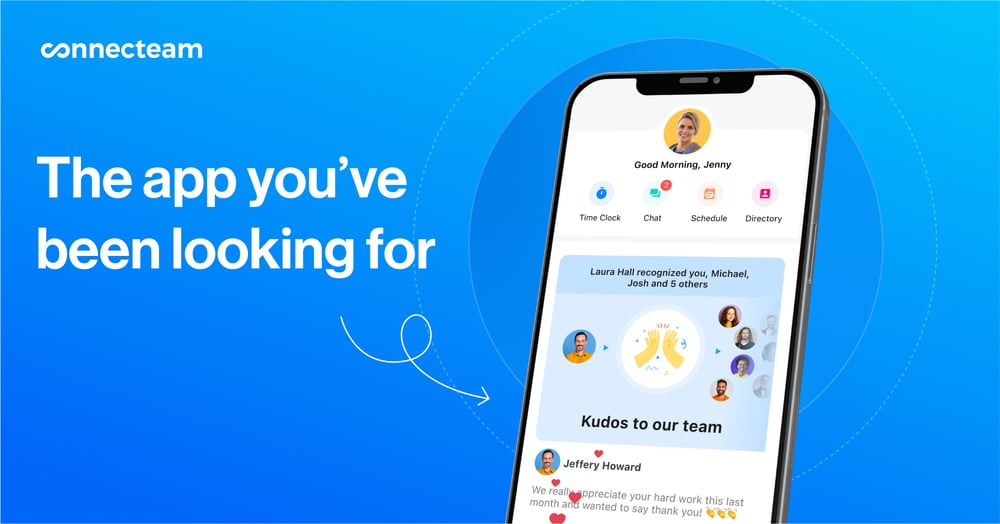Providing a positive employee experience increases productivity and satisfaction, meaning your workers will be more likely to stay with your company longer. In this article, we’re going over the importance of employee experience management and how digital tools can help.
Employee experience management affects your employees’ engagement and productivity levels, paving the way for better performances and reduced turnover. But what exactly is it? And how can you use it?
It’s not enough to simply give your employees tasks and goals and to monitor their progress. To get the most out of your workforce, you must also ensure that they feel valued.
Making sure your employees are happy and feel recognized is essential for workforce retention. The key is to listen to employee feedback at every stage of their employment lifecycle and provide a positive employee experience.
In this article, we’ll explain what employee experience managers do and effective strategies you can implement in your company to ensure your workers feel valued.
What is Employee Experience?
Employee experience refers to how employees interpret the interactions and experiences they have with an organization. The process starts with the recruitment and hiring process and includes everything from training, performance management, working conditions, and relationships with coworkers.
While employee experience is subjective and can be difficult to measure, employees who report a positive experience at work are more likely to have better workplace productivity, be more motivated, and stay with the company longer.
What is Employee Experience Management?
Employee experience management is the process of overseeing the employee lifecycle, from recruitment and onboarding to career development and employee offboarding.
Similar to how businesses create positive customer experiences, employee experience management involves ensuring employees are happy and engaged at work. Human resource departments and operations managers play a critical role in shaping the employee experience and consistently work to improve it. Some companies my even hire an employee experience specialist to manage this aspect of the business.
What Do Employee Experience Managers Do?
Sometimes referred to as employee experience specialists, these individuals are responsible for working collaboratively with many departments across an organization to create positive, supportive work environments. In short, employee experience managers are responsible for prioritizing employee well-being.
Because every company is different, employee experience managers need to tailor their approach to create the best possible work environment.
They may be involved in:
- Onboarding and training
- Employee events
- Ensuring eligible employees are granted leave in accordance with the Family and Medical Leave Act (FMLA)
- Collaborating with the company’s internal stakeholders so organizational policies are implemented correctly.
- Creating and implementing employee feedback surveys
- Overseeing internal communication
💡 Pro Tip:
Research shows that there is a strong correlation between employee satisfaction and workplace training. For a comprehensive overview of how to properly train employees, check out our ultimate guide on building effective training programs.
Why Employee Experience Management is Important
“Employee experience is an emerging space, and many organizations have only recently started using tools like HR analytics,” says Josh Blumenfeld, an Employee Experience Expert at Espresa, Inc.
“Another challenge—which I think most employee experience professionals face—is helping financial decision-makers understand the business benefits of investing in these types of programs and tools,” he continued.
So, what is the value of digital employee experience management?
Organizations are struggling more and more to attract and retain talented employees. But well-prepared employee experience managers can have huge business outcomes in the long term.
Even before an employee joins your company, they may be checking out company reviews for what it’s like to work for your company. This, in itself, is part of the employee lifecycle.
Proper digital employee experience management can positively impact your business by:
- Boosting performance: When employees feel connected and engaged at work and enjoy their day-to-day experiences, they will be more productive and generate better results.
- Reducing turnover: Employee experience management helps to increase employee engagement. According to studies, engaged employees are 87% less likely to quit their jobs, reducing training and recruiting costs.
- Unifying employees on company goals: Employee experience management provides clarity on business goals and allows employees to have a shared vision of what they are working to achieve.
How to Improve Employee Experience Management in Your Organization
Employee experience means looking at the bigger picture and the factors that influence how employees interpret their experiences at work.
Here’s how you can start to improve employee experience management in your business:
Consider the full employee journey
Employee experience management encompasses five key stages of the employee journey:
- Recruitment: Looking for a new job is stressful. The best way to attract potential candidates and ease their minds is by starting to provide a positive experience from the get-go. Put time and thought into employee ads by including detailed information about the role as well as the perks and benefits. Respond to candidate emails and phone calls quickly, and highlight the company culture to attract candidates to the role.
- Onboarding: Onboarding should help new employees understand the company’s overall goals and processes and provide them with the tools they need to succeed.
- Development: Employee development is an ongoing process that involves investing time and money into your employees to build their skill sets. Some questions to consider include: Are employees developing new skills? Can they get jobs done independently? Can they be promoted into roles with greater responsibilities?
- Retention: Hiring and training the right employees is one thing – but are you doing everything you can to keep them long-term? With a well-organized retention strategy, employees remain engaged and continue improving performance. After all, it can cost between 50%-60% of an employee’s salary just to replace them.
- Departure: There are many reasons an employee might leave your company. Maybe they are ready to retire, relocate, or simply start a new challenge. Whatever the case, every employee departure should help you evaluate your employee experience management and help you improve it for future hires. It’s essential to take note of employees’ reasons for leaving in their exit interviews.
Nurture the employee-employer relationship
The employee-employer relationship has a direct impact on employee morale, happiness, and productivity.
There are many ways employee experience managers can nurture employee-employer relationships to prevent negativity in the workplace, including:
- Frequent feedback
- Offer “psychological safety” – encourage your employees to be open with you and their managers. Allow them to discuss mistakes so they can learn how to prevent them in the future.
- Offer training and development to drive employee engagement and positive workplace culture.
- Prioritize and discuss mental wellness.
🧠 Did You Know?
Incorporating employee satisfaction surveys into your organization is a simple way to gather feedback and provide employees a platform to raise concerns.
With Connecteam’s built-in Survey capability,you can easily capture your employees’ thoughts and mood directly from the field, ensure every employee’s voice is heard & make informed decisions backed by real-time data.
Empower and recognize your employees
Empowered employees will do more for your company and will stick around longer. According to a study, 37% of employees said that they’d be more encouraged to produce better work if they were receiving an appropriate amount of recognition.
Employee empowerment is a continuous effort, and can be even more difficult with deskless employees. Recognizing your workers’ accomplishments, achievements, and even special occasions, can help convey how valued they are to the team and improve business outcomes.
Implement continuous healthy communication
Like any relationship, relationships with employees rely heavily on employee communication. Make sure you have the right tools to overcome communication problems and strategies in place to facilitate healthy relationships with your teams.
How Technology Enhances Employee Experience Management
Technology is a powerful tool that can be incredibly useful for improving the employee experience. Providing a digital employee experience that makes workers feel valued and acknowledged is key for employee satisfaction and retention rates.
Here’s how technology can help:
Improves communication
Open lines of communication between managers and employees is essential for well-functioning teams. Without it, collaboration, motivation, and productivity all suffer.
Fortunately, technology has come a long way and there are communication tools that not only radically simplify the process, but help teams stay aligned, deal with uncertainties, and feel valued by the company.
A digital communication system allows employees to:
- Message every employee and manager directly
- Access the employee phone directory
- Communicate with teams via group chat
- Send updates, announcements, and events
- Create and share schedules
- Share training programs and important documents
Offers a more streamlined work experience
Managers and employees, particularly frontline employees, have different needs. With the right digital management tool, you can streamline processes that may normally be cumbersome, like schedule sharing or communicating important changes and updates.
For example, an employee scheduling app allows managers to create schedules in advance and share them with their employees digitally. They also have full visibility of every employee’s availability right from their phone or computer, and can even include notes or instructions for each worker when they arrive at their job site.
Centralizes training and onboarding documents
We all know how frustrating it can be for an employee when they’re searching for resources during their onboarding and aren’t sure what to do and when.
With an employee experience management platform, like Connecteam, you can compile all of your team resources in one digital platform. Connecteam acts as your digital workplace, from ensuring employees have the necessary onboarding resources, making training courses available, and sharing the most up-to-date company protocols, it’s all possible with the right technology.
Additionally, apps that let you customize user permissions ensure that confidential information doesn’t get into the wrong hands.
📚 This Might Interest You:
Read our guide on the Best Employee Database Software in 2025.
Improves task management
What are the most challenging tasks your employees face? Once you answer this question, you can determine the right digital tools to reduce unnecessary friction and hassle on your team.
For example, in manufacturing companies, reporting to management is often tricky and requires finding the closest computer station in the warehouse. By using an employee management app and allowing teams to report from their mobile devices, employers make it easier for workers to do so. This increases the likelihood of accurate, detailed reports, and improves the employee experience.
📚 This Might Interest You:
Explore our list of the best employee management tools to streamline operations, enhance productivity, and improve team communication.
Bridges the gap between senior leadership and frontline employees
When managers engage and build relationships with their employees, company morale typically increases. A heightened sense of trust, value, and collaboration leads to increased happiness at work and productivity.
However, the larger the organization, the more significant the divide between senior management and frontline employees. Fortunately, employee experience management platforms can greatly help to minimize this gap.
Being able to reach all employees directly from their phone or desktop allows company managers to create better communication strategies, resulting in a more motivated workforce with a heightened sense of belonging.
The #1 Employee Experience Management App
Use Connecteam to Engage, Recognize, and Communicate Effectively With Your Employees
How Connecteam Can Improve Employee Experience Management
Connecteam is the best employee experience platform that gives you the tools you need to provide a positive employee experience by streamlining all aspects of your business operations–no matter where your employees are working from.
From keeping your team connected with the in-app chat feature to publicly acknowledging work anniversaries and birthdays with Connecteam’s employee recognition tools, Connecteam is the ideal employee experience management platform.

Employers are able to provide immediate and direct updates and announcements on the user-friendly newsfeed so everyone is always aware of what’s going on in the company. They can even send and collect polls and surveys so workers can actively provide input to company processes.
Another added bonus is that you can eliminate the need for a manual time clock with Connecteam’s easy-to-use time clock feature. It allows employees to clock in and out directly from their phones, no matter where they are. They can also view their schedules as soon as they’re published, allowing them to better balance work and personal life. They can even swap shifts with manager approval and request time off.
When it comes to job-specific tacks, your employees won’t be left confused or wondering about what they’re meant to do with Connecteam’s forms and checklists feature. Clarify what needs to be done during shifts directly in the app by including shift-specific checklists. You can also store important company documents directly on the app’s knowledge base, like training documents and policy updates, creating a collaborative, integrated, and seamless work environment.
The Bottom Line on Employee Experience Management
Employees are the cornerstone of every organization, and their experiences in the workplace have a huge effect on their happiness, motivation, and productivity.
Not only can employee experience management software provide essential digital tools like scheduling, time tracking, training, and payroll, but it directly benefits employee happiness by streamlining communication.
If you’re worried about your employees learning how to use a new, don’t be. Employee management apps, like Connecteam, are intuitive to use and have user-friendly interfaces that make it a breeze to install and use on a daily basis.




